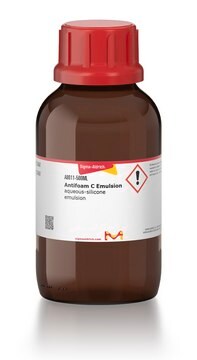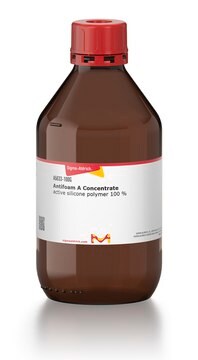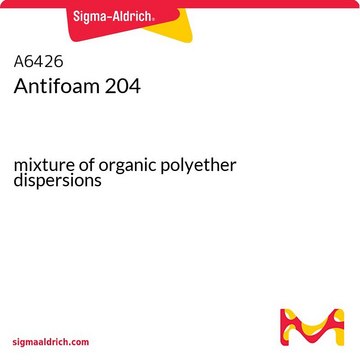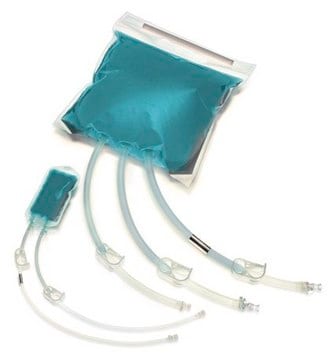A6582
Antifoam A concentrate
active silicone polymer 100%
Sinônimo(s):
Antifoam agent, Antifoam solution, Foam control agent
About This Item
Produtos recomendados
Nível de qualidade
forma
emulsion (aqueous)
técnica(s)
cell culture | hybridoma: suitable
microbiological culture: suitable
densidade
0.97 g/mL at 25 °C
aplicação(ões)
microbiology
temperatura de armazenamento
room temp
adequação
(Mammalian (suspension))
bacteria (fermentation)
Descrição geral
Aplicação
- in bioreactor culture for Staphylococcal enterotoxin C (SEC) production.
- to prevent foam formation during the aerobic treatment of sludge.
- to study the impact of surface tension on bioaerosol generation during bubbling.
Características e benefícios
- Molecular biology grade and tested for use in bacterial fermentation.
- Extremely effective foam suppressor for aqueous and non-aqueous systems.
- Made of 100% active silicone polymer, free of emulsifiers.
- Typically, effective at 1-100 ppm.
- Product will be stable in the pH range of 5 to 9.
- Can be directly added to a fermentation medium but it is not recommended that it be pumped to a fermenter on an as-needed basis.
Componentes
Nota de preparo
produto relacionado
Palavra indicadora
Warning
Frases de perigo
Declarações de precaução
Classificações de perigo
Aquatic Acute 1 - Aquatic Chronic 1
Código de classe de armazenamento
10 - Combustible liquids
Classe de risco de água (WGK)
WGK 3
Ponto de fulgor (°F)
>213.8 °F - closed cup
Ponto de fulgor (°C)
> 101 °C - closed cup
Equipamento de proteção individual
Eyeshields, Gloves, type ABEK (EN14387) respirator filter
Certificados de análise (COA)
Busque Certificados de análise (COA) digitando o Número do Lote do produto. Os números de lote e remessa podem ser encontrados no rótulo de um produto após a palavra “Lot” ou “Batch”.
Já possui este produto?
Encontre a documentação dos produtos que você adquiriu recentemente na biblioteca de documentos.
Nossa equipe de cientistas tem experiência em todas as áreas de pesquisa, incluindo Life Sciences, ciência de materiais, síntese química, cromatografia, química analítica e muitas outras.
Entre em contato com a assistência técnica








